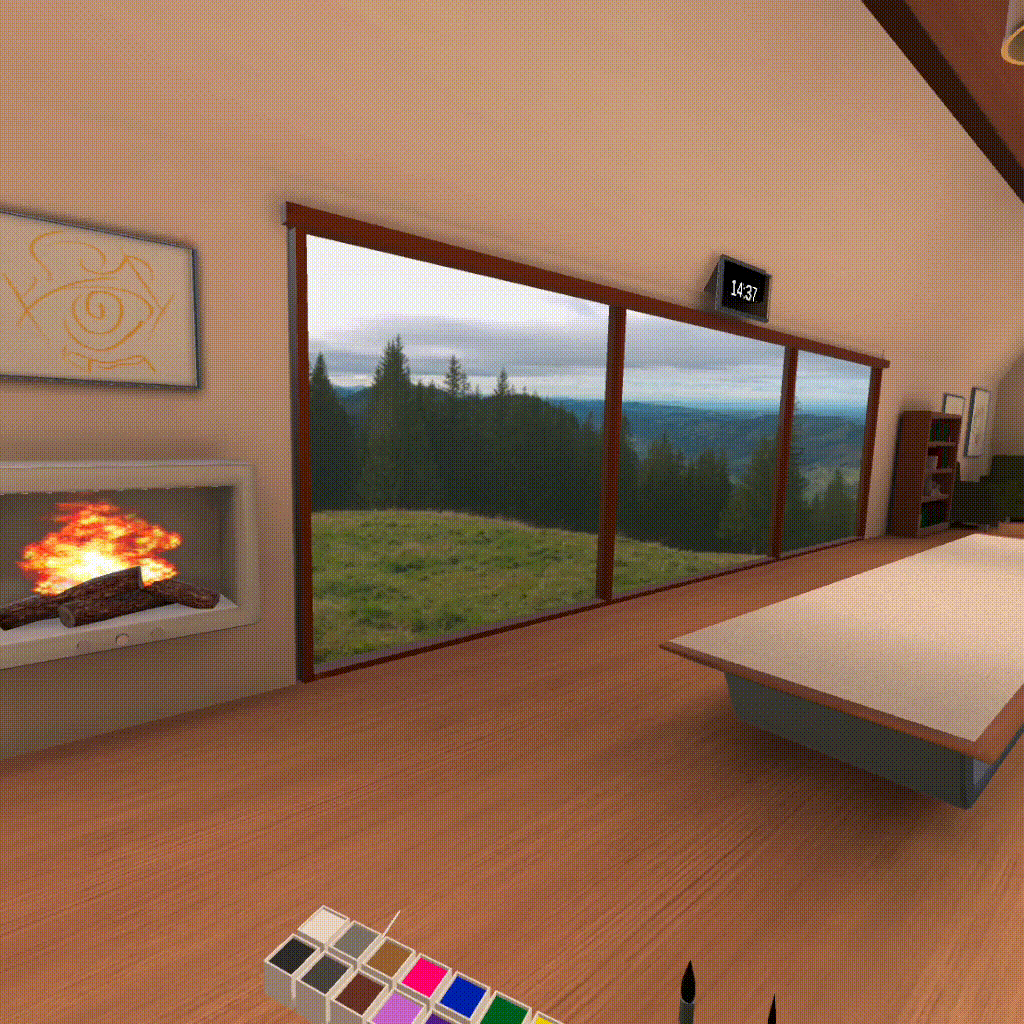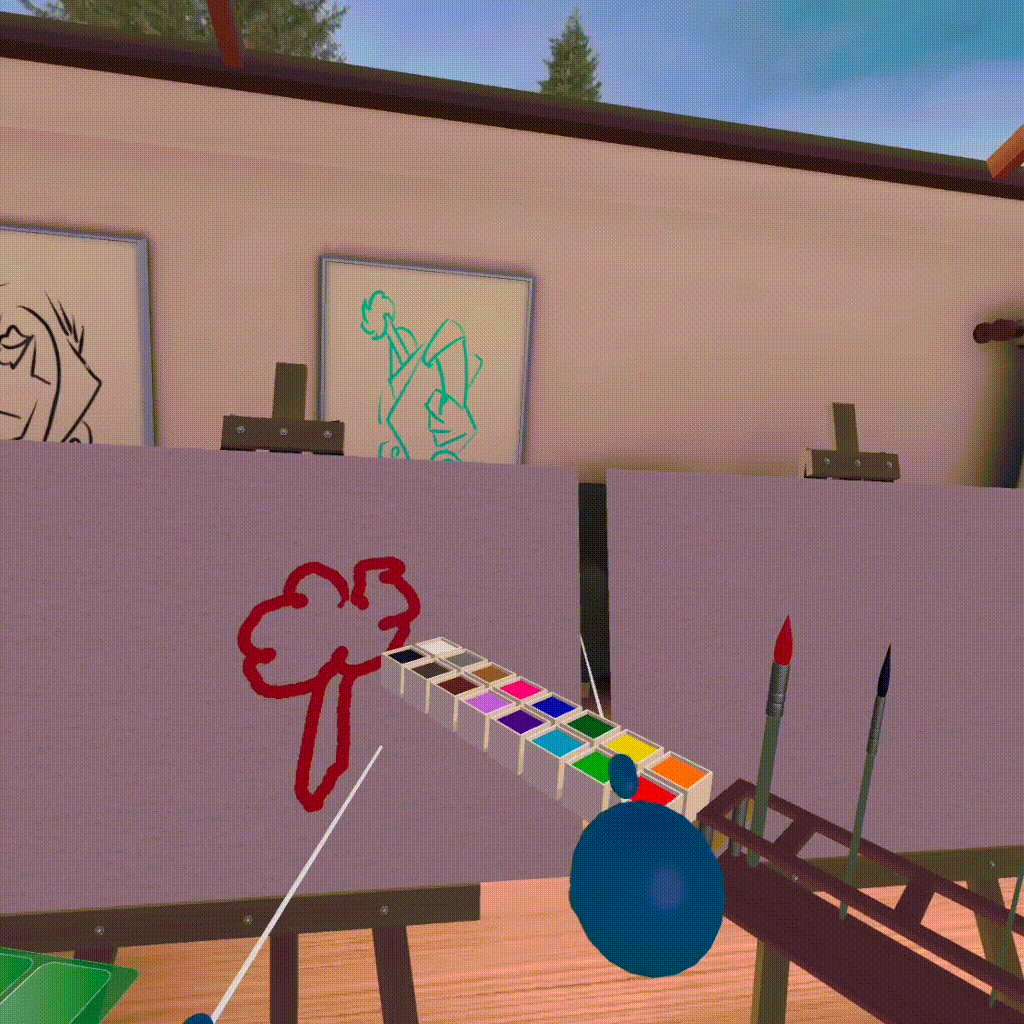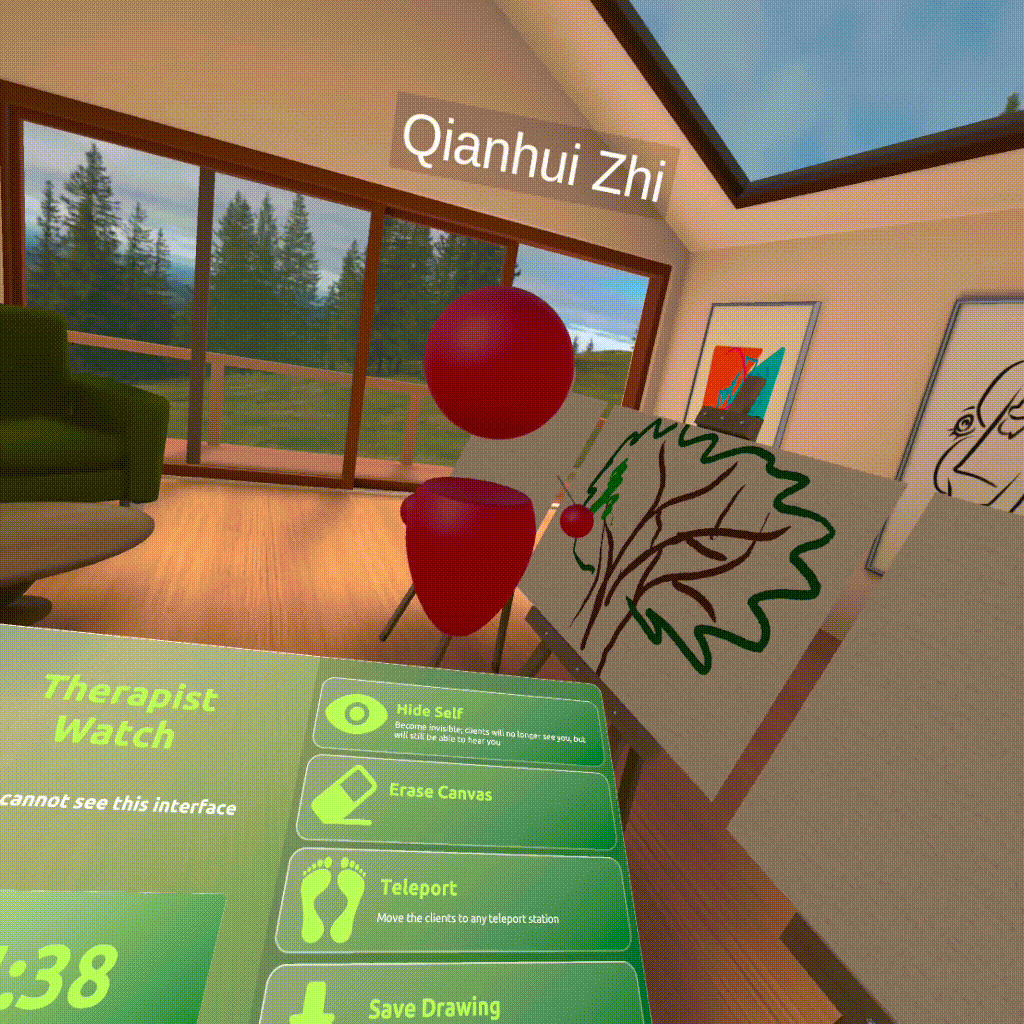September -- December 2021, VR UX
Created a VR app that supports art therapists to do remote art therapy sessions
Why
The art psychotherapy profession has undergone quite a few changes as a result of the epidemic. Both actively and forcibly, there has been a gradual wave of enthusiasm and fad among therapists to use online technology to conduct art psychotherapy remotely. However, the current remote tool -- zoom whiteboard was not user-friendly, either for the therapist or the client.
We wanted to make a platform specifically for remote art therapy that would allow therapists to better understand helping customers.
Overview
VR Art Therapy is an Oculus Quest 2 - based application that uses the advantages of VR over the physical world to create an intuitive multiplayer experience that gives art therapists a better option to help clients unlock and express their thoughts and feelings.
Our process is based on fast, iterative development, with frequent, playtests and regular feedback sessions by our New York University art therapy department collaborators and Carnegie Mellon University ETC instructors to ensure the comfort and usability of the virtual space and art tools we provide. While we are addressing a specific need for our client, we also hope to bring our own innovative ideas to the table.
The Project Goal
The goal of this project is to make virtual reality a medium that can help art therapists conduct remote art psychotherapy with their clients. The goal of this prototype is to explore how VR can address these limitations and enhance the experience while maintaining key aspects of the therapeutic process. For our deliverable, we aim to create a multiplayer space paired with an intuitive toolset that gives art therapists more options to help clients unlock and express their thoughts and feelings. Our ambition is to make an app with a strong foundation that can facilitate art therapists even though the VR headset cannot do facial expression recognition.
Project Challenge
-
Art therapy is divided into individual sessions and group sessions
-
Users are divided into art therapists and customers
-
VR devices cannot track facial expressions
-
Most people are not familiar with the operation of VR devices
My Role
As a solo UX designer and co-producer, I worked closely with a programmer and two artists to lead a collaborative user-centered design process. The usability testing and user interviews I facilitated helped us move beyond the status quo and strengthen our design strategy. While this was a short-term project of 12 weeks, I designed the signature experience concept and created a research-based, creative prototype. Otherwise, I also was responsible for creating the project website, poster, and half-sheet.
Link to project Website: https://projects.etc.cmu.edu/impression
Product Manager
Sole Product Designer
Website Designer
12 Weeks
Qianhui Zhi--Project Manager, Product Designer
Lauren Zhang--Project Manager, Tech Artist
Rui Zhang--Artist
Thomas Wrabets--Programmer
Figma, Adobe Illustrator, Adobe Photoshop, Miro
Project Preview

Waiting Room
The client's experience starts in a waiting room, mimicking the process of a therapy session in real life. Here, a client will pick the client role and a therapist will pick a therapist role. They will be able to personalize their username and get used to being in the VR space before starting the session in the main room.

Introduction Area
When the client enters the studio from the waiting room, he or she will wait for the therapist to appear at the introduction area - the conference table. This is in consideration of the fact that some clients are using VR for the first time and waiting in the chair will make them feel more secure. This also makes it easier for the therapist to introduce them to the whole art therapy process.

Different Drawing Position
There are individual and multi-person sessions for art therapy, as well as collaborative painting and separate painting. Moreover, the posture of the clients will also vary, some standing and some sitting. Taking these variables into account, three places for painting were finally designed: a canvas on the wall suitable for group art psychotherapy, a canvas on a large table suitable for sitting, and an easel suitable for single and multiple people to paint separately.

Teleport
Considering that therapists need to control the whole treatment process, we designed a smartwatch for therapists specifically. They can use this watch to look at the time and help the client move to the position where they need to paint (this is also considering that the client is not familiar with the operation of VR equipment). In order to make clients feel more comfortable in the studio, they are also free to move around in each painting area.

Clean Canvas
Considering that clients may misuse or experiment with colors and brushes, we have designed a clear board function for therapists, who can selectively clear the board.

Save Drawing
When the client finishes the painting, the therapist has the option to store his painting. If some clients want to store their own paintings, the therapist can share them with the client.
The Design Process

Brainstorming


Conclusion of Brainstorming
When performing art therapy, people need a comfortable, relaxing, and safe environment. People need a simple and intuitive tool to express their feelings of self. The therapist needs to observe and take control of the whole situation. To better communicate, they need to chat within the experience.
Initial Thinking
Target Users
-
Art therapists who want to do remote sessions for their clients.
-
Adults who want to do art therapy.
Research Methods
-
Guerilla research -- in-person & remote interviews & survey
-
Experiential research -- existing software and apps
Guerilla Research
End-User Needs Analysis
Question asked
-
How do therapists choose a medium to use?
-
How to measure the effectiveness of the tool?
-
What aspects of function do therapists need?
-
How will the therapist and client interact during a psychotherapy session?
-
What are the shortcomings and advantages of the tool of remote art therapy nowadays?
Takeaway
We met with Tom and Ikuko (Project Clients) at least once a week to gather more information, and clarify and solidify the project goals. A major point of discussion was the absence of video during the therapy session, for conveying facial expressions while in VR with the headsets on. We considered simply focusing on a browser-based experience that would keep this very important component intact, but ultimately decided to focus on exploring art therapy in VR medium only. This was partially a personal preference for our team members, but it also takes more advantage of the skills that the ETC fosters.
Some things we need to consider going forward are the implications of one-on-one and group art therapy, which seems to be the norm, and different ways for the therapist to observe the patient's process, potentially outside of the VR headset.
During several times meetings, our clients mentioned we need to focus on practicality--making something that is at least as good as in-person art therapy, over exploring more experimental possibilities. Thus, a major focus will remain on documenting how playtesters react to the spaces and interfaces we develop.
After communicating with our client about the design ideas for the VR scene, important information was received - the art therapist's office is an essential scene for therapists to do the session because they feel safe, comfortable, and convenient.
Experiential Research
Existing Systems Analysis
We hope to take advantage of the freedom of 3D bodily movement in VR and to playtest some existing VR spaces and VR art tools to get real user feedback before finishing and playtesting our first prototype. The first step in our research was to understand the strengths and weaknesses of the tools currently used by therapists in remote art therapy. We interviewed our end-user to understand his needs and request, then we explored many existing VR art tools as well as some similar studies. After that, we conducted user testing and interviews for the key product -- Tilt Brush.





Eric
40 year old
Producer
-
I hear echoes in the VR headset.
-
What am I supposed to do? I need some guidance.
-
An avatar would probably be better, or at least an upper-body avatar.
-
There are so many tools and features to choose from this panel that I don't know which one should I pick.
-
The tools work well.
It would be nice if there were some background images and models for me to use since I do not know how to draw.

Anjali
25 year old
Artist
-
I need around 10 min to familiar with the tools
-
I am not sure how to interact with therapist, and I feel uncomfortable when others watch me drawing
-
I like to stay in the VR world to talk about my drawing
-
I hope there is a better way for me to choose colors, here are too many choices for now
-
It doesn't need many kinds of tools, and changing the color is more important
-
Feel excited about having different backgrounds

Bob
27 year old
Producer
-
likes drawing in 3D compared to 2D
-
I am familiar with VR, so I feel comfortable drawing here
-
Too many tool options, I want to use all of them
- Can we change hand control? Left-handed right-handed?
-
I prefer to walk around to have more freedom to draw, because teleportation will break the flow of the painting

Lewis
30 year old
Programmer
-
Weird to have someone just looking at me and not doing anything
-
Wants to move around in the 3D world
-
In the beginning, it required some guidance and direction
-
I can see more options on the panel and color wheel but half of them are frustrating
-
Random teleport and location differences in VR (do not match the position in real life)
-
Feels disconnected as other clients can not be visualized
We invited four adults from different backgrounds and with varying levels of experience with VR to usability test the Tilt Brush and interview them.
-
People are intimidated and distracted by a complex, digital interface, they are easy to get lost in the interface.
-
Lots of confusion with VR tech alone (unrelated to software)because someone is not familiar with VR.
-
The environment people prefer varies.
-
Many felt that the different brushes “looked the same”
-
Need option to change left/right hand for drawing hand
Takeaway
Persona


Define the Problem
The usual art therapy process is 45 minutes to 60 minutes, sometimes delayed to 90 minutes. We assume that people need 5 to 10 minutes to get familiar with the prototype when using VR for art therapy remotely because we don't want to waste users’ too much time on hardware devices.
-
Therapists need to have a studio and be in control of the entire session to tell clients what they need to do.
-
Since there are single and multi-session, the studio needs to have different spaces for painting.
-
Customers need intuitive and easy-to-use tools to draw.
Key Features

Wireframes
Client Part Original Draft

Therapist Part Original Draft

Playtest

Revised Wireframes
Client Part Revised Version

Therapist Part Revised Version

Design Styles

Final UI Design


After opening the application, the user will first enter the waiting room, where he/ she can only see himself/herself. In the top right corner of the page, he/ she can view the list of producers of the application, and then in the bottom right of the page the user can choose his/her identity.

When the user selects the identity of the art therapist, he/she will be taken to this page where the system asks for the default name of this therapist and if the therapist needs to change their name.

When the user selects the identity of the customer, it will go to this page and the system will ask this user to enter his or her name to check in.

After the customer has successfully registered, he will see this screen and the system will ask him to wait for a moment in the waiting room.
Due to time constraints, this page was not implemented


Due to time constraints, this page was not implemented

Upon entering the studio, a translucent control panel will appear on the half wall facing the communication table. On this control panel, only the therapist can control. And the customer can tell the therapist which outdoor environment he wants to have, what kind of paint trays he plans to use, and what color canvas he needs.
Due to time constraints, this page was not implemented

From the customer's choices, it can also help the art therapist understand the customer's emotional state of mind. After the selection is made, click Confirm and the therapist can proceed to the next step and communicate with the customer at the conversation table.
Due to time constraints, this page was not implemented



In order to facilitate the art therapist to see the time and control the whole process, I designed the watch only for the therapist. This smartwatch can help the therapist to be invisible so as not to disturb the customer's painting process; it can help the therapist to clear a specific canvas; it can help the therapist to save a specific canvas; it can let the therapist help the customers to move to the target painting area quickly.
The interface on the right is designed for the therapist to better understand the situation in the waiting room and is an interface for the smart watch. However, due to time constraints, we did not implement this feature.
Due to time constraints, this page was not implemented

Reflection
At the end of that long process, we’ve learned quite a few things. One is the importance of incorporating intermediate designs into the prototype. Launching off from halves, we were sometimes stalled by over discussing/overdesigning something when we could just playtest it and see if it worked. Overcoming this helped us speed up our process. Another key lesson was digging into a client’s request to find the underlying need. Our client originally came into this project thinking the solution to VR art therapy would be a toolkit of different art mediums, but as we discussed and playtested our first art medium, we found that a platform needed to be built out to support the needs of therapy, before we could go too deeply into more art mediums. Similarly, when playtesting how “comfortable” the experience was, it wasn’t always enough to take what someone said at face value. For some people, we needed to break it down more, to get them to notice something. Lastly, we found that because our playtesting needs were quite complex, we had to make some compromises. For our in context playtests, we had a practice session with just the team and found that we couldn’t realistically use naive testers, since managing 4 people with limited familiarity with the app, and some being remote over Zoom, made it difficult to complete a playtest in a reasonable amount of time.